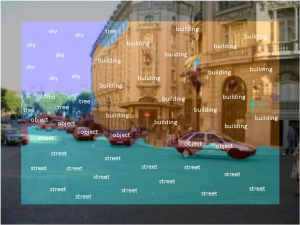Difference between revisions of "Scattering Networks for Scene Labeling"
From iis-projects
(Created page with "300px|thumb ==Description== Scattering networks [1,2] extract characteristic features from signals by recursively applying the composition of the f...") |
m (→Status: Available) |
||
| Line 10: | Line 10: | ||
===Status: Available=== | ===Status: Available=== | ||
| − | : Contact/Supervision: Michael Tschannen ( | + | : Contact/Supervision: |
| − | [[:User:Lukasc | Lukas Cavigelli]] | + | * Michael Tschannen (michaelt ät nari.ee.ethz.ch) |
| + | * Thomas Wiatowski (withomas ät nari.ee.ethz.ch) | ||
| + | * [[:User:Lukasc | Lukas Cavigelli]] | ||
| + | * Michael Lerjen (mlerjen ät nari.ee.ethz.ch) | ||
[[Category:Digital]] [[Category:System Design]] [[Category:Available]] [[Category:Semester Thesis]] [[Category:Master Thesis]] [[Category:Lukasc]] | [[Category:Digital]] [[Category:System Design]] [[Category:Available]] [[Category:Semester Thesis]] [[Category:Master Thesis]] [[Category:Lukasc]] | ||
<!-- | <!-- | ||
| Line 24: | Line 27: | ||
[[Category:Lukasc]] | [[Category:Lukasc]] | ||
---> | ---> | ||
| + | |||
===Prerequisites=== | ===Prerequisites=== | ||
: Matlab, C programming, linear algebra | : Matlab, C programming, linear algebra | ||
Revision as of 23:03, 24 September 2015
Contents
Description
Scattering networks [1,2] extract characteristic features from signals by recursively applying the composition of the following three operations: convolution with a set of filter functions, a non-linearity, and a sub-sampling step. Such networks, combined with a classifier (such as, e.g., support vector machines) were successfully employed in a number of classification tasks [1,3]. In contrast to traditional convolutional neural networks which learn the filters from training data [4], scattering networks use pre-defined filters such as wavelets [1], curvelets [2], or shearlets [2]. While a scattering network-based classifier arguably leads to less flexible machine learning models than convolutional network-based classifiers which learn the filters, they potentially allow for faster implementations thanks to the structure of the pre-defined filters (e.g., tensorized wavelet filters).
Consequently, this project shall explore the application of scene labeling, which aims at assigning a class label such as “street”, “tree”, or “building” to every pixel of an image and is employed, e.g., in situational awareness systems [4]. Such systems often demand low-complexity and low-power scene labeling algorithms and the scattering transform may help to meet these needs.
The goal of this project is to develop a scattering network-based classifier for scene labeling and to realize a GPU implementation thereof (followed by VLSI/FPGA, if time permits).
Status: Available
- Contact/Supervision:
- Michael Tschannen (michaelt ät nari.ee.ethz.ch)
- Thomas Wiatowski (withomas ät nari.ee.ethz.ch)
- Lukas Cavigelli
- Michael Lerjen (mlerjen ät nari.ee.ethz.ch)
Prerequisites
- Matlab, C programming, linear algebra
Character
- 0%-20% Theory
- 80%-100% Programming
Professor
tbd ↑ top
